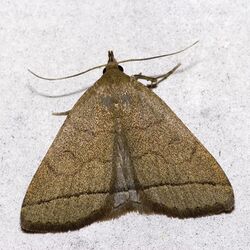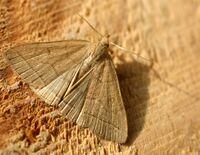Biology:Zanclognatha tarsipennalis
| Fan-foot | |
|---|---|

| |
| Scientific classification | |
| Domain: | Eukaryota |
| Kingdom: | Animalia |
| Phylum: | Arthropoda |
| Class: | Insecta |
| Order: | Lepidoptera |
| Superfamily: | Noctuoidea |
| Family: | Erebidae |
| Genus: | Zanclognatha |
| Species: | Z. tarsipennalis
|
| Binomial name | |
| Zanclognatha tarsipennalis (Treitschke, 1835)
| |
| Synonyms | |
| |
Zanclognatha tarsipennalis, the fan-foot, is a species of litter moth of the family Erebidae. It is found in Europe and east across the Palearctic to Siberia,[1] Amur, Ussuri, Japan , Taiwan, Korea and China .
Technical description and variation
The length of the forewings is 13–16 millimetres (0.51–0.63 in). Forewing narrower and greyer, less purple, than Polypogon lunalis Scopoli, 1763, sometimes with a yellowish flush; the inner and outer lines nearer together; the subterminal line simple, brown without any shade before, slightly concave outwards; the cell lunule obscurer; hindwing paler grey, the subterminal dark, strongly white-edged externally; the ab. bidentalis Hein. is paler grey, with a faint yellowish or rufous flush, the sub-terminal line of hindwing hardly angled. Larva dull grey; the dorsal line greyish black; tubercles black ringed with yellowish green; spiracles black; head black brown.[2]
Biology
The moth flies from May to October depending on the location.
The larvae feed on fallen leaves of European beech, oak and Rubus.
References
- ↑ "Herminia tarsipennalis". Fauna Europaea. 29 August 2013. http://www.faunaeur.org/full_results.php?id=446858.
- ↑ Seitz, A. Ed., 1914 Die Großschmetterlinge der Erde, Verlag Alfred Kernen, Stuttgart Band 3: Abt. 1, Die Großschmetterlinge des palaearktischen Faunengebietes, Die palaearktischen eulenartigen Nachtfalter, 1914.
External links
- Herminia tarsipennalis on UKmoths
- Herminia tarsipennalis on Lepiforum.de
- Herminia tarsipennalis on Vlindernet.nl (in Dutch)
Wikidata ☰ Q1781106 entry
 |



